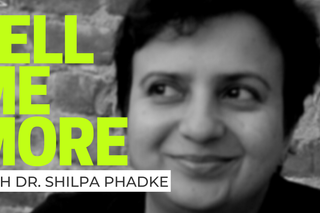
Tell Me More: Talking Urban Women’s Safety and Access With Dr. Shilpa Phadke
“The visions of who should be safe in a city always focus on able-bodied, cishet, middle-class women.”

In The Swaddle’s interview series Tell Me More, we discuss crucial cultural topics with people whose work pushes societal boundaries.
Dr. Shilpa Phadke is the co-author of Why Loiter? Women and Risk on Mumbai Streets and the Chairperson of the Centre for the Study of Contemporary Culture, School of Media and Cultural Studies at the Tata Institute of Social Sciences. The Swaddle’s Aditi Murti spoke to Dr. Phadke about what people mean when they talk about safe cities for women, and how informal surveillance prevents women’s free access to urban spaces.
The Swaddle: A lot of cities are declared “unsafe” or “safe” for women — what are the parameters that go into informing such declarations?
Dr. Shilpa Phadke: The parameters generally involve the way violence is reported. But this whole debate around whether a city is safe or not safe obscures the real question or the real intent, which is to suggest that somehow public spaces in cities are unsafe for women. You’ll know this because nobody talks about cities as safe or unsafe based on private or domestic violence. So they’ll call Delhi the rape capital of India, or when Mumbai has a sexual assault case, there will be a big headline saying Mumbai is now becoming Delhi.
I find the idea of safety itself in relation to how we see cities as a very limiting discourse. We must move to a language of access. Making a city more accessible — that is, better street lighting and functional public transport — can make a city more comfortable for women and other marginalized individuals. Then, we can move to a language of the right to risk, or loiter. Access is the bare minimum.
TS: When they say a city is safe for women, what type of women do they have in mind?
SP: The visions of who should be safe in a city always focus on able-bodied, cishet, middle-class women — the respectable woman in the Indian context. She’s the one we have to keep safe from “outside” men. These perpetrators tend to be envisioned as poor men, Muslim men, hawkers, and increasingly, migrant men.
There’s also the third category — the non-respectable woman, who contaminates the city with her presence. Which is why, in India, while sex work is legal, soliciting in public spaces is not. What this does is renders “respectable women” as outsiders to public space, and non-respectable women as contagions or threats to public space.
TS: I wonder if the neutral woman is also a specific age? Are risks to mothers and older women not given equal attention?
SP: Older women or women with children are immediately seen as respectable; it is younger, unmarried women who arouse suspicion and who often become targets of the discourse around safety. Interestingly, a lot of older women articulated greater access to public spaces due to visible signs of age, like gray hair, and a lifetime of experience strategizing safety in the city. So, they hold their bodies very differently in comparison to younger women who clutch their bags or books to their chest and are still learning how to navigate a hostile city.
In fact, older men felt a lot more unsafe as compared to how they felt as younger men. They feel vulnerable to incidences like robberies, because they’ve never had any experience strategizing how to navigate a city as young men due to the abundance of access they received.
TS: That is super interesting, but we still don’t see a lot of mothers and older women accessing public spaces for leisure, right? If you had to associate older women with a leisure activity, you’d think kitty party or society walks. Why are older women not out more often?
SP: While younger women may be watched more, they have more time for recreational activities. Once women marry and have children, there’s a huge drop in the amount of recreational time they have due to the increase in domestic work they become responsible for. I think that women often find that the work that they have expands to fill their day and thus, they tend not to not to be outside; but when they are outside, all the women’s experiences actually have a greater comfort than younger women’s experiences.
Another thing to pay attention to is access — women who are older may find it harder to access the city due to lack of resources built in for weaker, disabled individuals.
TS: In Why Loiter, you observed that the women in the city were hyper-visible. I was thinking about this romanticized idea of “blending into” a city, as an unseen observer, and was wondering if women could possibly blend into their surroundings at all?
SP: You constantly have to demonstrate a purpose if you are a woman in a public space. Particularly at night, you do become hyper-visible, right? Even public toilets close by 11 o’clock, suggesting that women don’t need to be out at all during the night. This does get slightly better during the daytime, where if you’re shopping or going to work — you can blend in. Access to public space and the ability to blend in increases if you’re able to look purposeful.
Universally, there are certain strategies that women use to access public spaces and this involves, say, wearing clothes that draw the least amount of attention. So you have baggy clothing, you carry large bags in order to look like you have a purpose, and you try in many ways to make yourself as minimally visible as possible so that you maximize your access to the public.
Women do not get free citizenship of the streets but do receive a kind of limited consumer citizenship. So you would have access to malls, to coffee shops, to restaurants, to pumps. However, we realized very quickly that while this kind of consumer citizenship is offered and a certain kind of middle-class woman, who is desirable in a public space because her presence buttresses the claims of, say, Mumbai as a “global city” — one where women are visible and have a certain amount of access. But even this consumer citizenship is contested. You’ll remember the 2009 Mangalore pub attacks where members of the Shri Ram Sena pulled women out of pubs and beat them up, or the 2017 New Year attacks in Bangalore, where women were molested on the streets — so this limited freedom is also not completely available.
Thirdly, it’s easier for women who appear cisgender or feminine to have more access within specific segregated spaces for women, like train compartments reserved for women. In fact, some women who dress too “butch” are often told to use men’s toilets. So yes, this is the kind of constant strategizing that goes on in order to claim the limited freedoms available in public spaces.
TS: There’s this assumption that certain parts of the city are “safer” because they are middle-class or upper-middle-class neighborhoods. Where does this assumption come from?
SP: There is definitely that perception, but our research shows that middle-class neighborhoods are no more or less safer than slum neighborhoods. In fact, certain aspects of the slum neighborhood — that they are alive and awake late into the night — make it safer than other residential neighborhoods, which have few shops and are dark and empty at night. The class of the individuals living in buildings didn’t make as much difference as whether there were shops, street lighting, and people on the roads.
But there’s definitely this perception of poor neighborhoods or, unfortunately, even Muslim neighborhoods, being unsafe spaces. People would name these areas as unsafe. When we’d ask them if they’ve been there, I kid you not over 85% of the time they had never been there. This was a vision they had conjured up entirely in their heads for women.
With respect to access and freedom, one thing we found was that buildings with homogenous communities (like Jain or Gujarati buildings) were more surveilled because people knew each other, belonged to the same communities, and reputations were at stake. This meant lesser freedom and access for women — particularly young single women who would potentially have arranged marriages. Their reputations as good women or good girls were a deeply relevant element here, which would decrease if they were spotted wearing short clothes or speaking to strange men.
Migrant women who came from other towns and cities reported the most access to public space. This was so even though these women had the least access to structural support within the city — they dealt with landlords and had no families to pick them up, so they worked out their own strategies on how to produce access and safety to themselves. But, because there was nobody watching them and nobody reporting back to their families, they actually experienced the greatest amount of access to public space.
TS: Did police presence ever contribute to the safety of a region?
SP: Not a single person reported feeling safe around the police. In fact, many women specified that if a police car pulls up next to your car or taxi at night, you should never stop. The lack of trust in police systems comes from their continuous discouragement and harassment of women who try to report sexual assault. For example, the police would take notes instead of registering a proper FIR when a woman tried to file a case. Recently, the Madhya Pradesh Chief Minister said that the police would track women for their safety and, trust me, that is the last thing women want.
Related on The Swaddle:
Madhya Pradesh CM Suggests Tracking Working Women To Ensure Their Safety
TS: After the December 2012 Delhi gang rape, one particular urban safety intervention put forth by several non-governmental organizations was crowd-mapping areas with high rates of sexual violence. Would such data be reliable?
SP: Crowdsourcing data has produced similar biases to the ones we encountered during our research interviews — that is, certain localities are more unsafe, and these areas tend to be poorer parts of the city. So, this produces a vision of a city that’s mapped by what is and what isn’t safe. Though several women across class barriers have access to smartphones and data, it is middle-class women who input this crowd-mapping data, which produces a middle-class vision and subsequent bias of the city.
However, I wouldn’t dismiss crowd-mapping just yet, because it can still provide the motivation to augment city infrastructures like street lighting and public toilets. But yes, it is limited in its capability to increase access.
TS: While thinking about the perceptions you’ve spoken about, I wondered if women were self-censoring their movement around the city due to deep-seated biases?
SP: Women are surrounded by narratives of danger, right? You look at a newspaper report and see headlines like “Fear stalks the city” — it gives off an impression that cities are unfriendly and hostile. Another thing that women grow up with is the victim-blaming associated with being attacked in a public space. So women always have the responsibility of producing safety for themselves, especially in the face of inadequate city infrastructure. On top of that, because they are second-guessing themselves so often, there is an inhibited access to public areas. This is not to say that women don’t fully access public spaces for education, employment, or even leisure — there is simply some strategy work involved before women leave homes like, say, going to the toilet before leaving so as to avoid public toilets, and planning public transports to avoid risks.
And despite all of these obstacles — both ideological and infrastructural obstacles — women, in many, many cities across the country, joyously access the public space either on their own or with friends and experience the sheer joy of being in a city. And part of it is really the pleasure of being innocent, the excitement that it offers, the edginess, the thrill, and the possibility that it all offers.
Aditi Murti is a culture writer at The Swaddle. Previously, she worked as a freelance journalist focused on gender and cities. Find her on social media @aditimurti.
Related


Slow Texters Are Making a Strong Case for Not Replying To Everything Instantly
